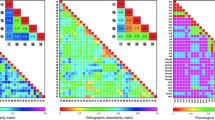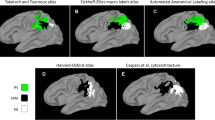Abstract
There have been several studies supporting the notion of a ventral-dorsal distinction in the primate cortex for visual object processing, whereby the ventral stream specializes in object identification, and the dorsal stream is engaged during object localization and interaction. There is also a growing body of evidence supporting a ventral stream that specializes in lexical (i.e., whole-word) reading, and a dorsal stream that is engaged during sub-lexical reading (i.e., phonetic decoding). Here, we consider the extent to which word-reading processes are located in regions either intersecting with, or unique from, regions that sub-serve object processing along these streams. Object identification was contrasted with lexical-based reading, and object interaction processing (i.e., deciding how to interact with an object) was contrasted with sub-lexical reading. Our results suggest that object identification and lexical-based reading are largely ventral and modular, showing mainly unique regions of activation (parahippocampal and occipital-temporal gyri function associated with object identification, and lingual, lateral occipital, and posterior inferior temporal gyri function associated with lexical-based reading) and very little shared activation (posterior inferior frontal gyrus). Object interaction processing and phonetic decoding are largely dorsal, and show both modular regions of activation (more lateralized to the dorsal-frontal right hemisphere for pseudohomophone naming, and more to the dorsal-frontal left hemisphere for the object interaction task) as well as significant shared regions of processing (precentral gyri, left inferior frontal cortex, left postcentral gyrus, left lateral occipital cortex, and superior posterior temporal gyri). Given that the perceptual experimental conditions show primarily modular and very little shared processing, whereas the analytical conditions show both substantial modular and shared processing, we discuss a reconsideration of “modularity of mind” which involves a continuum between strictly modular processing and varying degrees of shared processing, and which also depends on the nature of the tasks compared (i.e., perceptual versus analytical).
Similar content being viewed by others
References
Binder J, Price CJ. Functional neuroimaging of language. In: Cabeza R, Kingstone A, editors. Handbook of functional neuroimaging of cognition. Cambridge: MIT Press; 2001. p. 187–241.
Borowsky R, Cummine J, Owen WJ, Friesen CK, Shih F, Sarty GE. FMRI of ventral and dorsal processing streams in basic reading processes: insular sensitivity to phonology. Brain Topogr 2006;18(4):233–9.
Borowsky R, Loehr J, Friesen CK, Kraushaar G, Kingstone A, Sarty G. Modularity and intersection of ‹what’, ‹where’, and ‹how’ processing of visual stimuli: a new method of fMRI localization. Brain Topogr 2005;18:67–75.
Borowsky R, Owen WJ, Sarty GE. The role of the left hemisphere in motor control of touch: a functional magnetic resonance imaging analysis. Brain Cogn 2002;49(1):96–101.
Chao LL, Martin A. Representation of manipulable man-made objects in the dorsal stream. Neuroimage 2000;12:478–84.
Cox RW. AFNI: software for analysis and visualization of functional magnetic resonance neuroimages. Comp Biomed Res 1996;29:162–173. [AFNI 3-d anatomical brain available at: http:// www.afni.nimh.nih.gov/old/afni/astrip±orig.HEAD (and BRIK)].
D’esposito M. Functional neuroimaging of working memory. In: Cabeza R, Kingstone A editors. Handbook of functional neuroimaging of cognition. Cambridge: MIT Press; 2001. p. 293–327.
Fodor J. The modularity of mind. Cambridge: MIT Press; 1983.
Fodor J. The mind doesn’t work that way. Cambridge: MIT Press; 2000.
Friston KJ, Holmes AP, Price CJ, Buchel C, Worsley KJ. Multisubject fMRI studies and conjunction analyses. Neuroimage 1999;10:385–96.
Goldstein EB. Sensation and perception. 6th ed. Pacific Grove: Wadsworth-Thomson; 2002.
Goodale MA, Milner AD. Sight unseen: an exploration of conscious and unconscious vision. Oxford: Oxford University Press; 2005.
Hauk O, Pulvermuller F. Neurophysiological distinction of action words in the fronto-central cortex. Human Brain Mapp 2004;21(3):191–201.
Ishai A, Ungerleider LG, Martin A, Schouten JL, Haxby JV. Distributed representation of objects in the human ventral visual pathway. Neurobiology 1999;96:9379–84.
Kanwisher N, Downing P, Epstein R, Kourtzi Z. Functional neuroimaging of visual recognition. In: Cabeza R, Kingstone A editors. Handbook of functional neuroimaging of cognition. Cambridge: MIT Press; 2001. p. 109–51.
Kirk EC, Kay RF. The evolution of high visual acuity in the anthropoidea. In: Ross CF, Kay RF editors. Anthropoid origins: new visions. New York: Kluwer/Plenum Publishing; 2004, 539–602.
Martin A, Chao LL. Semantic memory and the brain: structure and processes. Curr Opin Neurobiol 2001;11:194–201.
Martin A. Functional neuroimaging of semantic memory. In: Cabeza R, Kingstone A editors. Handbook of functional neuroimaging of cognition. Cambridge MA: MIT Press; 2001, p.␣153–86.
Martin A. The representation of object concepts in the brain. Ann Rev Psychol 2007;58:25–45.
Martin A, Wiggs CL, Ungerleider LG, Haxby JV. Neural Correlates of Category-Specific Knowledge. Nature 1996;379: 649–52.
Milner AD, Goodale MA. The visual brain in action. Oxford: Oxford University Press; 1995.
Owen WJ, Borowsky R, Sarty GE. FMRI of two measures of phonological processing in visual word recognition: ecological validity matters. Brain Lang 2004;90(1–3):40–6.
Posner MI, Raichle ME. Images of mind. New York: Scientific American Library; 1994.
Price CJ, Friston KJ. Cognitive conjunction: a new approach to brain activation experiments. Neuroimage 1997;5:261–70.
Pugh KR, Mencl WE, Jenner AR, Katz L, Frost SJ, Lee JR, Shaywitz SA, Shaywitz BA. Functional neuroimaging studies of reading and reading disability (developmental dyslexia). Ment Retard Dev D Res Rev 2000;6(3):207–13.
Sarty G, Borowsky R. Functional MRI activation maps from empirically defined curve fitting. Magn Reson Eng 2005;24B:46–55.
Talairach J, Tournoux P. Co-planar stereotaxic atlas of the human brain. New York: Thieme Medical Publishers, Inc; 1988.
Tettamanti M, Buccino G, Saccuman MC, Gallese V, Danna M, Scifo P, Fazio F, Rizzolatti G, Cappa SF, Perani D. Listening to action-related sentences activates fronto-parietal motor circuits. J␣Cognitive Neurosci 2005;17(2):273–81.
Ullman MT. A neurocognitive perspective on language: the␣declarative/procedural model. Nat Rev Neurosci 2001;2: 717–26.
Ungerleider LG, Mishkin M. Two cortical visual systems. In: Ingle DJ, Goodale MA, Mansfield RJW editors. Analysis of visual behaviour. Cambridge: MIT Press; 1982. p. 549–86.
Vandenberghe R, Price C, Wise R, Josephs O, Frackowiak RSJ. Functional anatomy of a common semantic system for words and pictures. Nature 1996;383:254–256.
Acknowledgement
This research was supported by the Natural Sciences and Engineering Research Council (NSERC) of Canada in the form of grants to R.B. and G.E.S.
Author information
Authors and Affiliations
Corresponding author
Rights and permissions
About this article
Cite this article
Borowsky, R., Esopenko, C., Cummine, J. et al. Neural Representations of Visual Words and Objects: A Functional MRI Study on the Modularity of Reading and Object Processing. Brain Topogr 20, 89–96 (2007). https://doi.org/10.1007/s10548-007-0034-1
Accepted:
Published:
Issue Date:
DOI: https://doi.org/10.1007/s10548-007-0034-1




